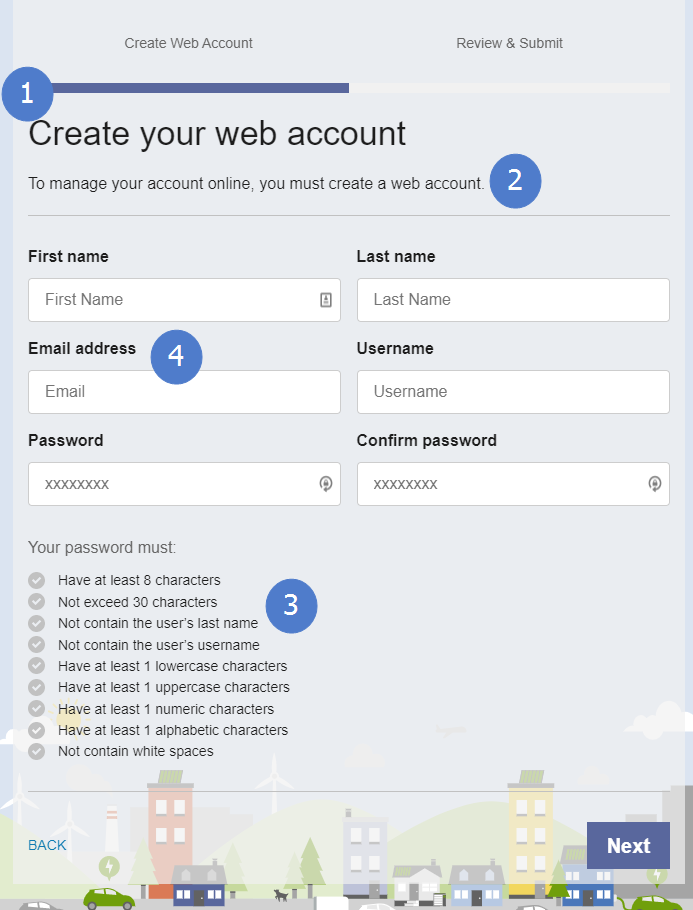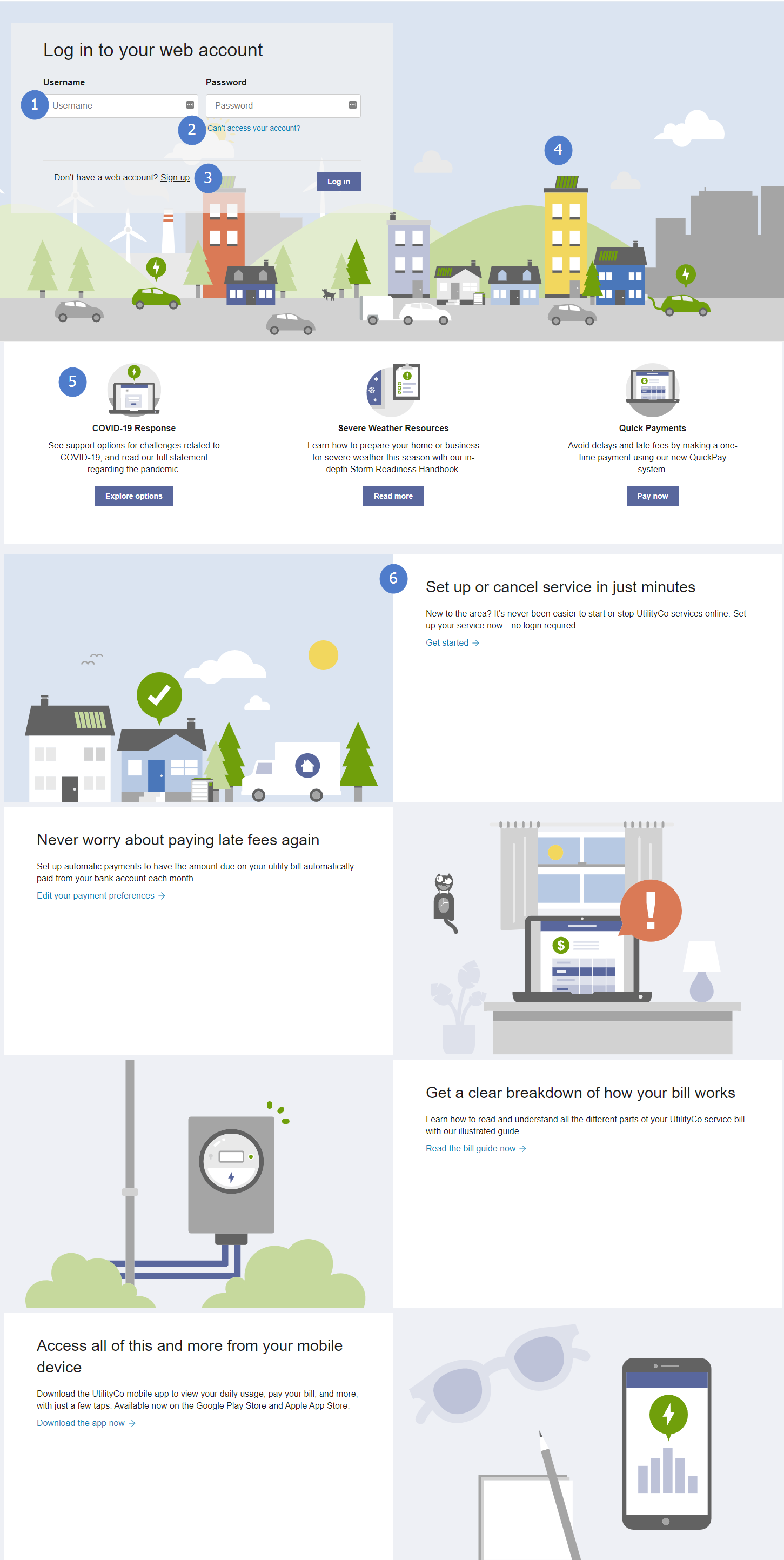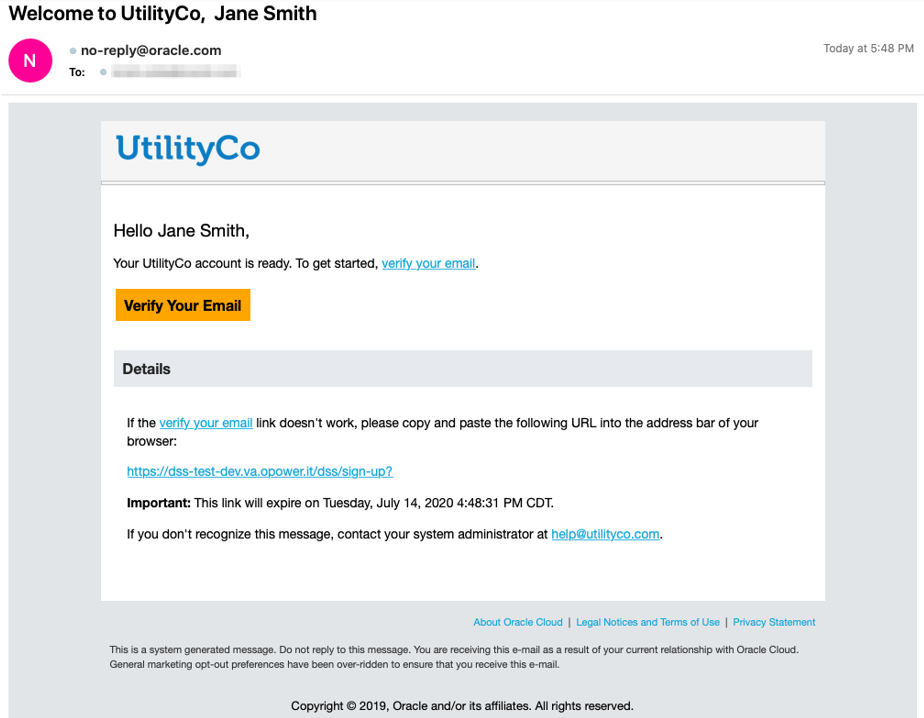Oracle Cloud Infrastructure Identity and Access Management User Experience
Digital Self Service - Transactions' built-in integration with Oracle Cloud Infrastructure Identity and Access Management includes features that allow customers to create an account, reset their password, and login with valid account credentials through the Digital Self Service - Transactions interface, as opposed to an external identity provider’s interface. Use the following information to review Oracle Cloud Infrastructure Identity and Access Management configuration options.
Registration
Digital Self Service - Transactions allows customers to create a web account to access their utility portal online.
Customers must complete fields that are required by Oracle Cloud Infrastructure Identity and Access Management, including:
- First name
- Last name
- Email address
- A password that meets the configured password requirements

| Image Number | Configuration Option |
|---|---|
|
1 |
Registration Widget Name The title for the registration widget. Default: Create your web account |
|
2 |
Sub header The supporting text for the registration widget. Default: To manage your account online, you must create a web account. |
|
3 |
Password Policy A simple, standard, or custom password policy must be configured in Oracle Cloud Infrastructure Identity and Access Management. Default: Standard |
|
4 |
Unique Email as Web Username Web account registration, login, and password reset is based on the customer's email address by default. Utilities can also enable users to register, login, and reset their password with a unique username instead of a unique email. If you enable a unique username instead of the default configuration that uses an email address, ensure that when defining invite guest user tasks, roles, and alerts, the Allow Duplicate Web User Email option is selected for linking self-service users. Default: Email |
|
Not Pictured |
Resend Verification Email The supporting text for the resend email link. Default: Didn't receive the email? Resend |
|
Not Pictured |
Resend Verification Email Success The supporting text for the resend email success message. Default: Email verification has been resent. Please check your inbox. |
| Not Pictured |
Terms and Conditions A terms and conditions link can be displayed, which sends users to the utility’s public terms and conditions page on their website. Customers are required to select the terms and conditions checkbox to confirm that they agree to the terms and conditions as part of their account registration. Default: False |
Login
The login to Digital Self Service - Transactions requires a registered email address and password. Customers may also access a link to sign up for an account or a link to reset their password so they may complete these processes online.

| Image Number | Configuration Option |
|---|---|
|
1 |
Login ID Customers can log in using a unique email address or username. Default: Email |
|
2 |
Account Recovery Link A link to allow the customer to reset their own password. Default: The "Can't access your account?" link directs users to the account recovery widget. |
|
3 |
Sign Up Link A link to allow the customer to sign up for a web account if they don’t have an existing login. Default: Links to Registration Widget |
| 4 |
Background Image An image can be displayed as the background of the login area. The background is also displayed on the Password Reset and Registration widgets if enabled. Utilities may use the default background image and work with Oracle Utilities to customize its colors to meet their brand guidelines per the utility branding guidelines in the Oracle Utilities Opower Platform Configuration Guide. Default: A graphic city-scape image, as shown in the example above. |
| 5 |
Quick Links The quick links section includes three configurable links that support an image, title, description, and call to action button that links to additional resources. Be aware that links must redirect users to content that does not require authentication, as these links are provided on the login page and thus customers are not yet signed in to their accounts. The quick links are enabled by default and use the following default content. If enabled, applicable content must be provided for the three quick link slots, including an applicable redirect link. If disabled, the entire quick links section is hidden. Utilities may use the default quick link images and work with Oracle Utilities to customize their colors to meet their brand guidelines per the utility branding guidelines in the Oracle Utilities Opower Platform Configuration Guide. Defaults:
|
| 6 |
Content Blocks Content blocks are full-width spaces to promote utility programs and content. At least one content block is required with a maximum of four. Content blocks support a title, description, call to action link, and image. Be aware that links must redirect users to content that does not require authentication, as these links are provided on the login page and thus customers are not yet signed in to their accounts. Utilities may use the default content block images and work with Oracle Utilities to customize their colors to meet their brand guidelines per the utility branding guidelines in the Oracle Utilities Opower Platform Configuration Guide. Defaults:
|
| Not Pictured |
iFrame Slot A full-width content block can be enabled to embed and display iFrame content beneath the content blocks. Default: Disabled |
|
Not Pictured |
Redirect URL The destination after login. Default: Account Overview |
Account Recovery
An Account Recovery widget helps Digital Self Service - Transactions customers regain access to their account. A valid email address or username must be provided for the customer to receive the password recovery email. If the customer has forgotten their registered email address, or has multiple usernames associated with the same email address, they must contact customer service to regain access to their account.

| Image Number | Configuration Option |
|---|---|
|
1 |
Login ID Customers can trigger a password reset notification based on their email address or username. Default: Email |
|
Not Pictured |
Destination URL The destination after login. Default: /dss/overview |
Edit Password
Customers can select to Manage Web Account to manage their web account. From the Web Login Details, customers can select the Edit password option to change their password directly within Digital Self Service - Transactions.

Reset Password
Users can be required to reset their passwords in the following scenarios:
- Expired Password: Oracle Cloud Infrastructure Identity and Access Management administrators can configure passwords to expire after a defined number of days. If a customer’s password has expired and they try to log in with their previous password, they are redirected to the password reset page. The customer is required to provide their current password and set a new password in accordance with the current password policy to regain access to their account.
- Password Reset Forced by an Administrator: Oracle Cloud Infrastructure Identity and Access Management administrators can force all users to set a new password on their next login. This action can be taken when the password policy is modified, and this reset ensures that customer passwords meet the new criteria
When an administrator forces a password reset, customers receive an automated email with a link to reset their password. If the customer attempts to log in with their previous password after an administrator forces a password reset, an error message is displayed until their password has been reset.
Notifications
Integration with Oracle Cloud Infrastructure Identity and Access Management leverages email notifications at key steps in the customer journey. For example, after a user is created manually or through self-registration, they will receive a welcome email. When they activate their account, they will then receive an activation email.

When Oracle Cloud Infrastructure Identity and Access Management is used for authentication to Digital Self Service - Transactions, customers can receive email notifications in their preferred language. For example, if a customer defines their preferred language as Spanish within Digital Self Service - Transactions, the notifications they receive directly from Oracle Cloud Infrastructure Identity and Access Management display content in Spanish.
The language must be supported by all integrated products for customers to receive a notification in the respective language. Languages that are supported by Oracle Cloud Infrastructure Identity and Access Management, Customer Care and Billing, and Digital Self Service - Transactions include:
- English
- Spanish
Supported User Notifications & Templates
Self-Registration Email Verification: After successfully creating an account, this notification is sent to the user to verify the email address.
Welcome Self-Registration User: After successfully creating an account, this notification is sent to the user. The notification contains a link that the user clicks to activate the account.
Password Recovery Request: This notification is sent to a user if the user requests a password reset. This notification contains a URL that the user clicks to be redirected to the Password Reset page. The user provides a password as part of the password recovery process. After the activation process is complete, the user is logged in automatically.
Password Change: This notification is sent to the end user to inform the user that the password is changed successfully. This event is initiated by the end user.
User Account Locked: An end user is notified that their account in Oracle Cloud Infrastructure Identity and Access Management is locked.
User Account Unlocked: An end user is notified that their account in Oracle Cloud Infrastructure Identity and Access Management is unlocked.
User Exceeded the Maximum Number of Account Recovery Attempts: After a user exceeds the maximum number of attempts to reset their password to recover their account, this notification is sent to the user's primary email address.
Resend Welcome: This notification is sent when the user does not click the activate your account link in the Welcome notification. The notification contains a link that the end user clicks to activate the account.
In addition to the standard notifications listed above, the following notifications are supported when a utility requires customers to register with a separate username and email address.
Recovery Email Verification: After a user changes their password recovery email address, this notification is sent to the user to verify the address.
Primary Email Verification: After a user changes their primary email address, this notification is sent to the user to verify the email address.
Secondary Email Verification: After a user changes their secondary email address, this notification is sent to the user to verify the email address.
Recovery Email Update: After a user changes their password recovery email address, this notification is sent to the user confirming the change.
Primary Email Update: After a user changes their primary email address, this notification is sent to the user confirming the change.
Secondary Email Update: After a user changes their secondary email address, this notification is sent to the user confirming the change.
Third-Party Applications
A utility's online portal can require that authenticated web applications are available to their customers alongside Digital Self Service - Transactions to maintain a single, integrated experience for their customers. For example, a utility can link to a customer rewards program and website directly from Digital Self Service - Transactions, redirecting the customer without requiring them to log in again.